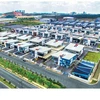
Singapore (VNA) – Singapore’s economy grew 2.9% year on year in the second quarter of 2024, comparable to the revised growth rate of 3% in the previous quarter, going by advance estimates from the Ministry of Trade and Industry (MTI) on July 12.
On a seasonally adjusted, quarterly basis, the city-state's gross domestic product (GDP) rose 0.4%, up from the previous quarter’s revised 0.3% growth rate. Year-on-year growth beat economists’ expectations of 2.7%, while quarter-on-quarter growth was in line with their forecast.
That came after the first quarter growth was revised higher to 3% - the fastest pace since the 4.2% expansion in the third quarter of 2022.
The growth was supported by a rebound in the manufacturing sector to 0.5% expansion year on year after a 1.7% contraction in the first three months of the year.
Along with construction that grew 4.3%, the overall goods producing industry posted an expansion of 1.3% versus contraction of 0.7%.
The manufacturing sector's expansion in the second quarter was aided by output expansions across all its clusters, except for biomedical manufacturing and precision engineering.
On a quarter-on-quarter seasonally adjusted basis, manufacturing grew by 0.6%, rebounding from the 5.3% contraction in the first quarter.
The jump in manufacturing was powered by the electronic sector’s robust growth of 20.1% against a 1.1 contraction in April. The strongest performance within electronics was from the semiconductor segment that rebounded by 20.6% in May after shrinking 2.6% in April and 14.3% in March.
Most analysts had then said that the demand for chips and other electronics exports is strengthening, supported by new consumer and business replacement cycles for smartphones and computers, as well as growing demand for generative AI applications./.






















